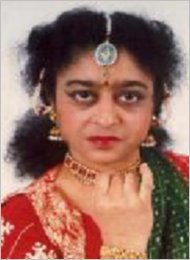 |
 |
Panchbhut: Elements of Nature Saturday November 22nd 2003 Dance Festival of India 2003, Thomas Jefferson Theater, Arlington, VA An Audience Review by Mary Hope Schwoebel January 8, 2004 Asha Vattikuti's beautiful Kathak ballet entitled "Panchbhut: Elements of Nature" was not only beautiful to see and hear, it was also intellectually and emotionally engaging. Kathak dance is intrinsically entertaining due to the beauty and the athleticism of the technique. This is not surprising, given its history. Kathak evolved as an entertainment for the Moghul conquerors of Hindu India who did not understand and/or were not interested in the complex stories from the great Hindu epics upon which, traditionally, most Indian dance was based. Thus the graceful arabesques formed by the hands and arms, the dazzling spins, the compelling rhythms produced by the footwork, and the sumptuous costumes are mesmerizing. . |
 |
| "Panchbhut:
Elements of Nature" offered all this and much more. The production presented
representations through the musical selections and the choreography, of
the elements of nature, enhanced with slide shows and voice-overs, culminating
with the composite of the elements - Mother Earth herself, danced by Asha
Vattikuti. The substance of this professional-level production contained
multiple levels of meanings and messages. The elements of nature were employed
artistically, scientifically, metaphorically and spiritually. Part of the
ingeniousness of the performance was that different audiences might perceive
different moral or ethical messages embedded in it.
This viewer has attended scores of non-Western dance performances over the course of 25 years, and can thus assert with confidence, that "Panchbhut: Elements of Nature" was one of the most effective at translating and interpreting Eastern philosophy for a Western and/or westernized audience that this viewer has ever witnessed. This has particular relevance to the Washington DC metropolitan area, and especially to Northern Virginia. People from every corner of the globe have made their homes in Northern Virginia - it is the future face of America. Mainstream audiences in Northern Virginia, including young people, are already familiar with and appreciate Latino, Middle Eastern, Pacific Island, and African performing arts. However, South Asian and Far Eastern performing arts have not yet penetrated the mainstream to the same extent. This may be due in part to the complexity of these arts and the deeper level of knowledge required to understand and appreciate them. However it is easy to imagine that once they are understood, they will take audiences by storm. The Washington
DC area has become known as a place where traditional performing arts are
being sustained and even revived, even where they are no longer practiced
or have been forced underground in their geographical sources. For example,
both the Beijing Opera and the Cambodian royal court dancers are now based
in the area. Some of these dance forms, such as flamenco and hula are almost
as known and loved by local audiences as are the Western dances of ballet
and tap. These dances are being nurtured and revitalized because the interest
in them has resulted in a growth in the numbers of students, practitioners,
and performance opportunities. This has happened in part because performance
formats have been made accessible to mainstream audiences and because teaching
methods have been adapted to Western lifestyles and learning styles.
There are ongoing
discussions surrounding the pros and cons of such adaptations and concessions
to the 'modern' lifestyle and the 'modern' audience. There are also ongoing
discussions surrounding the pros and cons of adherence to tradition versus
innovation, as well as the rewards and risks of fusion.
|